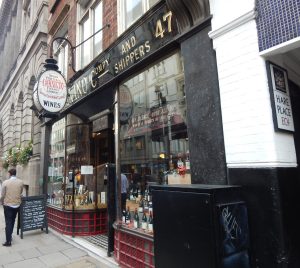Walking on the ‘wrong side’ of the pavement
All of our first year law undergrads took part in an exercise in week one of their LLB where they escaped City and went to visit a number of buildings of significance in the local area, before tackling some research questions.
They were then asked to write a blog post inspired by their travels. 21 winners were selected from all those posts submitted – this is one of those – thanks to Philopateer Zaki-Azat. His piece is subtitled: London from the eyes of an international City Law School student
A successful lawyer requires more than just monetary ambition; they need perseverance, persistence, determination, diligence, patience, sociability and many more qualities. Coming to law school was not an easy decision for me, I am not only entering a new field of study but a whole new country, and so, my decision to attend law school was not taken lightly.
Leaving Canada was hard, but as soon as I stepped into the OTLT lecture hall, I felt like this is where I was meant to be, a point in my life’s journey that all my decisions had led up to, an opportunity where I get to make a contribution and difference in the legal system. Besides the obvious; driving on the right, half-way crosswalks, tube maps, and, as the title stated, walking on the wrong side of the pavement, adjusting to the lifestyle in London was difficult.
Being in London for the first week, I only knew how to get from my flat to City University and from City to the nearest Nando’s. I was then very thankful for our “Out and About” exercise, because it was a great opportunity, for, not only myself, but all my colleagues to go out, get to know each other and see the sites of London.

Our first ‘Out and About’ task was to visit the statue of John Wilkes on Fetter Lane (the ugliest man in England), a moment that really broke the ice between our group members. Following that, we visited Wildy’s book store, which held books from the 1830’s. We then found ourselves in front of our next landmark: El Vino’s Pub. I want to take a short reflection on our visit here. As prominently known, El Vino’s was held under allegations of prejudice against women.
The case developed in 1983 in which the Court of Appeal ruled that, “the operation of ‘men only’ area in a wine bar (men were permitted to stand at the bar whereas women were required to sit at a table) is a breach of the Sex Discrimination Act.”[1] After conducting research on the case, I learned that the movement of feminism was a change, not only against sexual discrimination, but on the basis of equality of the constitution’s landscape, and later had much influence on the 1998 Human Rights Act. The idea was not just to enforce feminist visions in the law, but to establish the root of the constitution and legal system in the society, and ensure that it be unprejudiced to any gender or race. Beautifully put in an article written by Harriet Samuels, “Feminist interventions also offer an opportunity to build a litigation strategy that will help shape the development of the case law under the Human Rights Act 1998.”[2]
My thoughts pondered on constitutional equality until the reaching of our last landmark: the unmistakable Royal Court of Justice. The Royal Court of Justice included many divisions of courts; Court of Appeal, High Courts and Tribunals, and undoubtedly, the Supreme Court. My thoughts on legal equality mused even more, stretching from gender inequality in EL Vino’s, to the lack of gender equality in the Supreme Court. As the irony is seen, currently only 1 of our 12 Supreme Court Justices is female. The notion is not that she is female; but rather that she is the only female. My theory does not base itself on gender type, but rather the portrayal of equality in the legal system itself that governs us all. “In January 2004, Lady Hale became the United Kingdom’s first woman Lord of Appeal in Ordinary after a varied career as an academic lawyer, law reformer, and judge. In October 2009 she became the first woman Justice of the Supreme Court.”[3] As Lady Justice might say, lawyers must swear to uphold the law, to bring forth justice blindly of race and gender, and to ascribe innocence to every accused person unless proven guilty through the weighing of evidence. However the judicial system itself is not based on these foundational values. This might be a precarious thing to say, nevertheless the contradiction stands: what lies between those who aspire to uphold justice and equality compared to the justice and equality established within those who aspire to uphold it?
As a City law student I strive to critically understand these problems, to create solutions to these issues, and if not solutions, then awareness to challenge the norms. Such that even if I am forced to walk on the ‘right side’ of the pavement, those strangely looking at me in question, may try to walk on the ‘wrong side’ of the pavement.
[1] Gill v El Vino Co Ltd [1983] QB 425. Read Guardian story on this – 30 years on: El Vino’s treatment of women drinkers ruled unlawful
[2] Harriet Samuels, ‘Feminist Legal Studies’ [2005] 13(1) Feminist Activism, Third Party Interventions and the Courts 15-42
[3] Supremecourtuk, Biographies of the Justices <accessed 30 September 2015>

